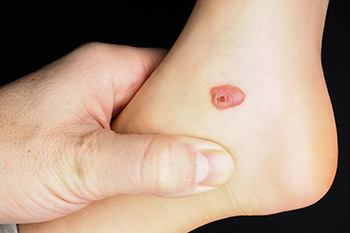
Foot blood blisters are small pockets of fluid that form between the layers of skin in response to friction or pressure. They typically occur when blood vessels near the skin's surface rupture, causing blood to pool within the blister. These blisters can vary in size and may appear red, purple, or even black due to the presence of blood. Common causes of foot blood blisters include wearing ill-fitting shoes that rub against the skin, excessive friction from activities such as running or hiking, and repetitive trauma to the feet. Additionally, certain foot deformities like bunions or hammertoes can predispose individuals to developing blood blisters. Athletes and individuals who spend prolonged periods on their feet are also at increased risk. Preventing foot blood blisters involves wearing properly fitted shoes, using protective padding or bandages on areas prone to friction, and gradually increasing activity levels to allow the skin to adapt. Proper foot care and attention to footwear can go a long way in reducing the likelihood of developing these painful blisters. If you have developed a blood blister on your foot, it is suggested that you visit a podiatrist who can inspect and treat this foot condition.
Blisters may appear as a single bubble or in a cluster. They can cause a lot of pain and may be filled with pus, blood, or watery serum. If your feet are hurting, contact Dr. Odin De Los Reyes of Connecticut. Our doctor can provide the care you need to keep you pain-free and on your feet.
Foot Blisters
Foot blisters are often the result of friction. This happens due to the constant rubbing from shoes, which can lead to pain.
What Are Foot Blisters?
A foot blister is a small fluid-filled pocket that forms on the upper-most layer of the skin. Blisters are filled with clear fluid and can lead to blood drainage or pus if the area becomes infected.
Symptoms
(Blister symptoms may vary depending on what is causing them)
- Bubble of skin filled with fluid
- Redness
- Moderate to severe pain
- Itching
Prevention & Treatment
In order to prevent blisters, you should be sure to wear comfortable shoes with socks that cushion your feet and absorb sweat. Breaking a blister open may increase your chances of developing an infection. However, if your blister breaks, you should wash the area with soap and water immediately and then apply a bandage to the affected area. If your blisters cause severe pain it is important that you call your podiatrist right away.
If you have any questions, please feel free to contact our offices located in Southbury and Farmington, CT . We offer the newest diagnostic and treatment technologies for all your foot care needs.
